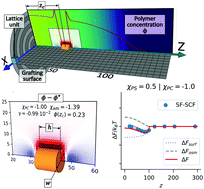Colloidal particles interacting with a polymer brush: a self-consistent field theory†
Abstract
The interaction of colloidal particles with a planar polymer brush immersed in a solvent of variable thermodynamic quality is studied by a numerical self-consistent field method combined with analytical mean-field theory. The effect of embedded particle on the distribution of polymer density in the brush is analyzed and the particle insertion free energy profiles are calculated for variable size and shape of the particles and sets of polymer–particle and polymer–solvent interaction parameters. In particular, both cases of repulsive and attractive interactions between particles and brush-forming chains are considered. It is demonstrated that for large particles the insertion free energy is dominated by repulsive (osmotic) contribution and is approximately proportional to the particle volume in accordance with earlier theoretical predictions [Halperin et al., Macromolecules, 2011, 44, 3622]. For the particles of smaller size or/and large shape asymmetry the adsorption or depletion of a polymer from the particle surface essentially contributes to the insertion free energy balance. As a result, depending on the set of polymer–solvent and polymer–particle interaction parameters and brush grafting density the insertion free energy profile may exhibit complex patterns, i.e., from a pure repulsive effective potential barrier to an attractive well. The results of our study allow for predicting equilibrium partitioning and controlling diffusive transport of (bio)nanocolloids across (bio)polymer brushes of arbitrary geometry including polymer-modified membranes or nanopores.



 Please wait while we load your content...
Please wait while we load your content...